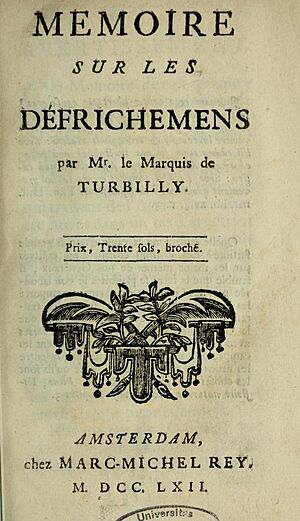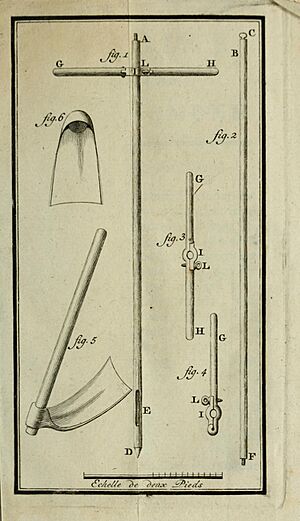Louis François Henri de Menon facts for kids
Louis-François-Henri de Menon, Marquis de Turbilly (born in Fontenailles, 1717 – died in Paris, 25 February 1776) was a French agronomist. An agronomist is someone who studies and improves farming and land use. He wrote an important book called Mémoire sur les défrichements in 1760, which was about clearing land for farming.
Contents
About Louis-François-Henri de Menon
Louis-François-Henri de Menon was born into an important family from Anjou, a region in France. His family had owned land there since the 1300s. He went to school at the college of the Jesuits in La Flèche.
His Time in the Army
After finishing school, Louis-François-Henri de Menon joined the army in 1733. He was part of the Normandy regiment. During the War of the Polish Succession, he showed great bravery at the Siege of Philippsburg in 1734.
He became a captain in 1737. In 1740, he joined a cavalry regiment from Roussillon. When his father passed away in 1737, Louis-François-Henri inherited a large estate. He started making big improvements to the land, making the farm work more organized and efficient.
He had to return to his regiment for the War of 1741, but he left his estate in the care of a skilled manager. During the War of the Austrian Succession, de Menon fought in different parts of Europe, including Bohemia and Westphalia. He later joined the Regiment of Saxony. He received a special award called the Order of Saint Louis. He also took part in important battles like the sieges of Antwerp and Brussels, and the Battle of Rocoux. In 1747, he was seriously hurt in the Battle of Lauffeld, which meant he had to leave the army.
Improving Farmland
After leaving the army, Louis-François-Henri de Menon went back to his estates in the South of Mayenne, in the Anjou region. He is famous for his work on clearing land. When he inherited his estate in 1737, about 1000 hectares (which is like 2,500 acres) near Baugé was mostly wild and unused.
He worked hard to improve the land by clearing away forests and adding drainage systems. He turned his estate into a model farm. He cleared the heather that covered much of the land around Villiers. He also created pathways to make the land more useful for farming. Forty years later, his land had become one of the richest in the whole region.
De Menon became a friend and advisor to the minister Henri Léonard Jean Baptiste Bertin. He helped inspire a new rule in 1760 that encouraged people to create agricultural societies. He also influenced the French government's decision in 1761 to support clearing land for farming. In 1762, he was chosen as a fellow of the Royal Society, a famous group of scientists, under the name Francois-Henri, Marquis de Turbilly.
He started two awards for the best wheat and rye harvests in his area. The awards included money and a medal. This was the first time such awards were given in France. He also had the idea to set up farming societies across the country. Another of his ideas was to stop the practice of begging, and he successfully did this on his own lands.
De Menon also started new farming activities. He grew hemp, which is used to make ropes and fabrics. He also started raising silkworms to produce silk. He even built a small factory to make soap and another one to make terracotta roof tiles. Towards the end of his life, he began fish farming. His last big project was to produce porcelain, but this led to many legal and money problems.
His large projects needed a lot of money. Some of his ideas did not work out well in the first few years. Eventually, he lost all his money. His property was taken by people he owed money to. Just before he passed away in Paris on February 25, 1776, he had given up control of his estate.
His Lasting Impact
Louis-François-Henri de Menon did not have any children. After he died in 1776, his land was sold to pay his debts. An Irish nobleman bought the estate. In 1787, the famous English agronomist Arthur Young visited the estate. He had traveled all the way from England to Mayenne to see de Menon's work. Young found clear signs of the improvements de Menon had made over nearly forty years. He wrote an interesting report about it in his travel books.
The famous writer Voltaire even mentioned de Menon (as Marquis of Turbilly) in his poem Epître à madame Denis sur l'agriculture (Letter to Madame Denis on agriculture). Voltaire wrote:
- From a desolate area, the inhabitant gets rich
- Turbilly in Anjou imitates you and applauds you
However, Voltaire did not mention de Menon or his work in de Menon's own book, Mémoire sur les défrichements.
In 1777, a book called The Complete Farmer: Or, a General Dictionary of Husbandry was published. In this book, de Menon (as Marquis de Turbilly) was listed as one of the most important experts on farming. Other famous people mentioned in the book included Carl Linnaeus, Jethro Tull, and Arthur Young.



